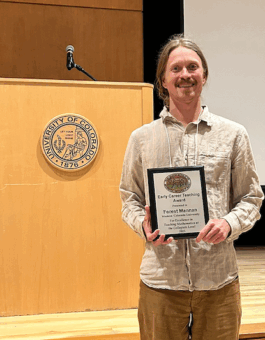Enabling Equitable Energy Solutions
An effort to bring critical solutions to renewable energy has landed two Western Colorado University alumni on a prestigious list of names.
Forbes Magazine has named Western grads Maria Agazio and CJ Gooderham as part of its “30 under 30,” for their cofounding of “Equitable Energy Solutions™ (ESS™).” For more than a decade Forbes has had reporters, editors and expert judges choose 30 top entrepreneurs each in a variety of categories, such as energy, finance, art and style, and many others. The top 30 are evaluated on numerous factors such as funding, revenue, social impact, inventiveness, and potential. Agazio and Gooderham were named in the energy category.
It Began with a Capstone Project
Agazio and Gooderham created ESS™ with other Western students as their Capstone project in the Environment and Sustainability (ENVS) course, Applied Sustainability. Director of the undergraduate ENVS program and instructor for the course, Dr. Kate Clark described the Capstone course as emphasizing autonomy, creativity and building a sense of ownership. She celebrated the students for living up to the course challenge to, “leave a legacy at Western.”
The capstone students never intended to create a company, rather they explored solutions proposed by their mentor and cofounder, Rich Stromberg, who challenged the students with repurposing solar panels near the end of their warranty life to “create the greatest value for those with the greatest need.” The solar photovoltaic equipment was being replaced by companies and was destined to be sent to a landfill. Yet, the solar panels were still functional, producing more than 80% of their original output. Over the course of the semester, it became clear that the solution was not only a capstone project but a novel social movement with the potential to become a sustainable business model.
“The last thing we want to do is fill up the landfills with good, functioning equipment,” said Stromberg. “Instead, we want to use these assets to help people who need them the most. Low-income households have been left out of the clean energy revolution while these same people experience a higher energy burden that is more than 2.5 times that of upper income households.”
How a Good Idea Can Take Flight
Stromberg said that solar array system owners both residential and commercial are upgrading to new equipment so this kind of exchange will become more common.
For Agazio and Gooderham, the project went far beyond just the environmental and social benefits. The students learned how a good idea can take flight.
“It quickly became apparent that this project was going to require the balancing of all things business, engineering, and financing among many other things. It also became clear that there was an enormous need in the marketplace and a wave of panels headed for the landfill,” said ESS™ co-founder Agazio.
The students developed a nonprofit concept so they could provide tax deductions to equipment donors and then pitched their idea to Coldharbour Institute, which works closely with the Clark School to offer a living laboratory in sustainability solutions to Western students. With Coldharbour’s approval of the proposal, ESS™ went from concept to a strategic program of an established nonprofit within three months.
“This work is so important,” said M.J. Pickett, executive director of Coldharbour, who noted the environmental benefit of keeping functioning equipment out of landfills, while easing the energy burden on low- to medium-income households. “This program helps make solar energy accessible to all in our community.”
Current Students Taking Up the Cause
Since the launching of the nonprofit, another group of Capstone students have taken up the cause. A pilot project was completed by installing a 5.5-kilowatt solar array on the Gunnison ice rink at Jorgensen Park. The energy savings are directed to the Gunnison Valley Regional Housing Authority’s energy efficiency program for low-income households. Other projects with Habitat for Humanity and the Colorado Energy Office have been done, including repurposing a solar-powered charger for a wheelchair user.
Both Agazio and Gooderham continue to support the work done by the new class of ESS students. Gooderham said his “near term dream” is for the organization to repurpose a 1 megawatt (1000 kilowatts) of solar power to underserved communities.
“We have so much work to do and so much opportunity ahead of us. With a lot of hard work, and a lot of luck, we have the opportunity to create a unique solution to one of the biggest challenges facing the solar industry and a carbon free future,” said Gooderham. “Not only would (a 1-megawatt project) prove the concept to the solar industry, but it would serve so many families in need of energy equity.”
Learn more about Agazio and Gooderham and Forbes 30 Under 30 online and read about the Equitable Solar Solutions project.
Discover Western’s Environment and Sustainability Program.
Author Credit: Chris Rourke
Photo Credit: Courtesy


